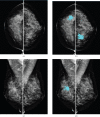Computer-aided detection of breast masses depicted on full-field digital mammograms: a performance assessment
- PMID: 21343322
- PMCID: PMC3120913
- DOI: 10.1259/bjr/51461617
Computer-aided detection of breast masses depicted on full-field digital mammograms: a performance assessment
Abstract
Objectives: To investigate the feasibility of converting a computer-aided detection (CAD) scheme for digitised screen-film mammograms to full-field digital mammograms (FFDMs) and assessing CAD performance on a large database.
Methods: The database included 6478 FFDM images acquired on 1120 females, with 525 cancer cases and 595 negative cases. The database was divided into five case groups: (1) cancer detected during screening, (2) interval cancers, (3) "high-risk" recommended for surgical excision, (4) recalled but negative and (5) negative (not recalled). A previously developed CAD scheme for masses depicted on digitised images was converted and re-optimised for FFDM images while keeping the same image-processing structure. CAD performance was analysed on the entire database.
Results: The case-based sensitivity was 75.6% (397/525) for the current mammograms and 40.8% (42/103) for the prior mammograms deemed negative during clinical interpretation but "visible" during retrospective review. The region-based sensitivity was 58.1% (618/1064) for the current mammograms and 28.4% (57/201) for the prior mammograms. The CAD scheme marked 55.7% (221/397) and 35.7% (15/42) of the masses on both views of the current and the prior examinations, respectively. The overall CAD-cued false-positive rate was 0.32 per image, ranging from 0.29 to 0.51 for the five case groups.
Conclusion: This study indicated that (1) digitised image-based CAD can be converted for FFDMs while performing at a comparable, or better, level; (2) CAD detects a substantial fraction of cancers depicted on prior examinations, albeit most having been marked only on one view; and (3) CAD tends to mark more false-positive results on "difficult" negative cases that are more visually difficult for radiologists to interpret.
Figures






Similar articles
-
Effect of computer-aided detection on independent double reading of paired screen-film and full-field digital screening mammograms.AJR Am J Roentgenol. 2007 Feb;188(2):377-84. doi: 10.2214/AJR.05.2207. AJR Am J Roentgenol. 2007. PMID: 17242245
-
A method to test the reproducibility and to improve performance of computer-aided detection schemes for digitized mammograms.Med Phys. 2004 Nov;31(11):2964-72. doi: 10.1118/1.1806291. Med Phys. 2004. PMID: 15587648
-
Improving performance of computer-aided detection of masses by incorporating bilateral mammographic density asymmetry: an assessment.Acad Radiol. 2012 Mar;19(3):303-10. doi: 10.1016/j.acra.2011.10.026. Epub 2011 Dec 14. Acad Radiol. 2012. PMID: 22173323 Free PMC article.
-
[Application of a computer-aided detection (CAD) system to digitalized mammograms for identifying microcalcifications].Radiol Med. 2001 May;101(5):334-40. Radiol Med. 2001. PMID: 11438784 Italian.
-
[Understanding CAD (computer-aided diagnosis) in mammography].J Radiol. 2005 Jan;86(1):29-35. doi: 10.1016/s0221-0363(05)81319-8. J Radiol. 2005. PMID: 15785414 Review. French.
Cited by
-
Improving Performance of Breast Lesion Classification Using a ResNet50 Model Optimized with a Novel Attention Mechanism.Tomography. 2022 Sep 28;8(5):2411-2425. doi: 10.3390/tomography8050200. Tomography. 2022. PMID: 36287799 Free PMC article.
-
Developing global image feature analysis models to predict cancer risk and prognosis.Vis Comput Ind Biomed Art. 2019;2(1):17. doi: 10.1186/s42492-019-0026-5. Epub 2019 Nov 19. Vis Comput Ind Biomed Art. 2019. PMID: 32190407 Free PMC article.
-
Developing a new case based computer-aided detection scheme and an adaptive cueing method to improve performance in detecting mammographic lesions.Phys Med Biol. 2017 Jan 21;62(2):358-376. doi: 10.1088/1361-6560/aa5081. Epub 2016 Dec 20. Phys Med Biol. 2017. PMID: 27997380 Free PMC article.
-
Improving the performance of computer-aided detection of subtle breast masses using an adaptive cueing method.Phys Med Biol. 2012 Jan 21;57(2):561-75. doi: 10.1088/0031-9155/57/2/561. Phys Med Biol. 2012. PMID: 22218075 Free PMC article.
-
Bilateral mammographic density asymmetry and breast cancer risk: a preliminary assessment.Eur J Radiol. 2012 Nov;81(11):3222-8. doi: 10.1016/j.ejrad.2012.04.018. Epub 2012 May 12. Eur J Radiol. 2012. PMID: 22579527 Free PMC article.
References
-
- Freer TM, Ulissey MJ. Screening mammography with computer-aided detection: prospective study of 12,860 patients in a community breast center. Radiology 2001;220:781–6 - PubMed
-
- Gur D, Sumkin JH, Rockette HE, Ganott M, Hakim C, Hardesty L, et al. Changes in breast cancer detection and mammography recall rates after the introduction of a computer-aided detection system. J Natl Cancer Inst 2004;96:185–90 - PubMed
-
- Khoo LA, Taylor P, Given-Wilson RM. Computer-aided detection in the United Kingdom National Breast Screening Programme: prospective study. Radiology 2005;237:444–9 - PubMed
-
- Ko JM, Nicholas MJ, Mendel JB, Slanetz PJ. Prospective assessment of computer-aided detection in interpretation of screening mammograms. AJR Am J Roentgenol 2006;187:1483–91 - PubMed
Publication types
MeSH terms
Grants and funding
LinkOut - more resources
Full Text Sources
Medical
Miscellaneous

